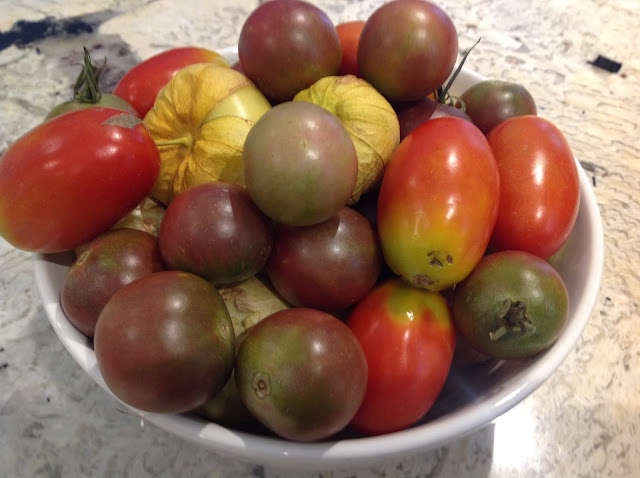Do you like guacamole? You will love this tomatillo guacamole just as much. Tomatillos, like tomatoes, are in season right now and they add an interesting flavor to regular guacamole. Traditionally, I add chopped tomatoes to my guac; This time I added chopped tomatoes and chopped tomatillos. I made it in the food processor in literally 2 minutes and didn't even wait to make this fabulous party dip for my next party. We ate it as a light dinner!!
I picked my tomatillos from my CSA farm. In addition to all the other fabulous produce this week, I was able to pick 2 quarts of golden tomatillos. I was surprised how flavorful and sweet these tomatillos tasted!
How to eat tomatillos
We ate a lot of them just like a tomato, either sliced or added to salad, or we just bit into them and ate the whole thing like a fruit because it was a little sweet. They are a little firmer than a tomato. These seemed a little sweeter and riper than the ones I've gotten in the stores. Maybe because they were a little more yellow ? or are there different varieties??? Does anyone know???
Since I still had some of these beauties left over, I decided to use them for this simple tomatillo avocado guacamole, which of course is absolutely delicious! It's one of the easiest dips to make and is low carb and healthy. I actually used slices of tomatillo as my dippers.
Tomatillos can also be cooked- see "my notes below" # 5 for how to cook tomatillos plus 5 recipes
When you are thinking about party or snack food, think healthy! This dip is made from avocado, tomatoes, tomatillos, parsley, and scallions-all vegetables that are naturally gluten free, fresh, and good for you. Why sit and eat store bought dip that isn't fresh and probably has additives when you can make this nutrient and enzyme rich dip in minutes.
No tomatillos?- Try my regular guacamole : Basic Guacamole
Tomatillos can also be cooked- see "my notes below" # 5 for how to cook tomatillos plus 5 recipes
When you are thinking about party or snack food, think healthy! This dip is made from avocado, tomatoes, tomatillos, parsley, and scallions-all vegetables that are naturally gluten free, fresh, and good for you. Why sit and eat store bought dip that isn't fresh and probably has additives when you can make this nutrient and enzyme rich dip in minutes.
No tomatillos?- Try my regular guacamole : Basic Guacamole
Ingredients:
2-3 medium tomatillos ( tomatillos are on the small side)
2 medium Hass type avocados, peeled and quartered
juice of 1/2 fresh lemon ( about 1/4 cup of juice)
3 large sprigs of parsley
2 scallions stems , chopped
Salt and cracked pepper to taste ( I used a little Himalayan pink salt)
Salt and cracked pepper to taste ( I used a little Himalayan pink salt)
optional: 1 teaspoon of cumin ( I used it and thought it needed it -but if you don't like cumin omit it)
Directions:
Place all of the ingredients in the food processor . Turn on 2-3 burts ( on off, on off, on off) until slightly blended. Serve with gluten free crackers, celery sticks, or slices of tomatillo.
I'll be linking this post to these blog carnivals
How do you use tomatillos?- Please share in the comments
My Notes:
1. My number one reason for joining an organic CSA is to get fresh organic produce that is still bursting with enzymes! Enzymes are what help us digest our food and get the most benefit of the vitamins and minerals
.
2. My number two reason is that I love connecting to the earth. The farm is so peaceful and serene. I love spending time there in nature.
3. # 3 reason: I love that the CSA introduces me to locally seasonal vegetables that I probably might never try, like tomatillos! I love trying new vegetables especially when they are organic. Another vegetable that I never tried before was kohlrabi! You can learn about kohlrabi on my post where I ended up making it into kohlrabi lentil soup
4. I try to add as many vitamin rich spices like cumin to my recipes. It is amazing how beneficial spices are. Most cultures have always depended on spices like turmeric, cumin, garlic, etc. for their health benefits.
5. Tomatillos can be eaten raw or cooked- here is a link I found at Organic Authority for
How to Cook tomatillos and 5 amazing recipes ( use GF tacos in her recipes)
How do you use tomatillos?- Please share in the comments
My Notes:
1. My number one reason for joining an organic CSA is to get fresh organic produce that is still bursting with enzymes! Enzymes are what help us digest our food and get the most benefit of the vitamins and minerals
.
2. My number two reason is that I love connecting to the earth. The farm is so peaceful and serene. I love spending time there in nature.
3. # 3 reason: I love that the CSA introduces me to locally seasonal vegetables that I probably might never try, like tomatillos! I love trying new vegetables especially when they are organic. Another vegetable that I never tried before was kohlrabi! You can learn about kohlrabi on my post where I ended up making it into kohlrabi lentil soup
4. I try to add as many vitamin rich spices like cumin to my recipes. It is amazing how beneficial spices are. Most cultures have always depended on spices like turmeric, cumin, garlic, etc. for their health benefits.
5. Tomatillos can be eaten raw or cooked- here is a link I found at Organic Authority for
How to Cook tomatillos and 5 amazing recipes ( use GF tacos in her recipes)
#1636, 1661, 1650, 1629 full size render 37







Komentar
Posting Komentar